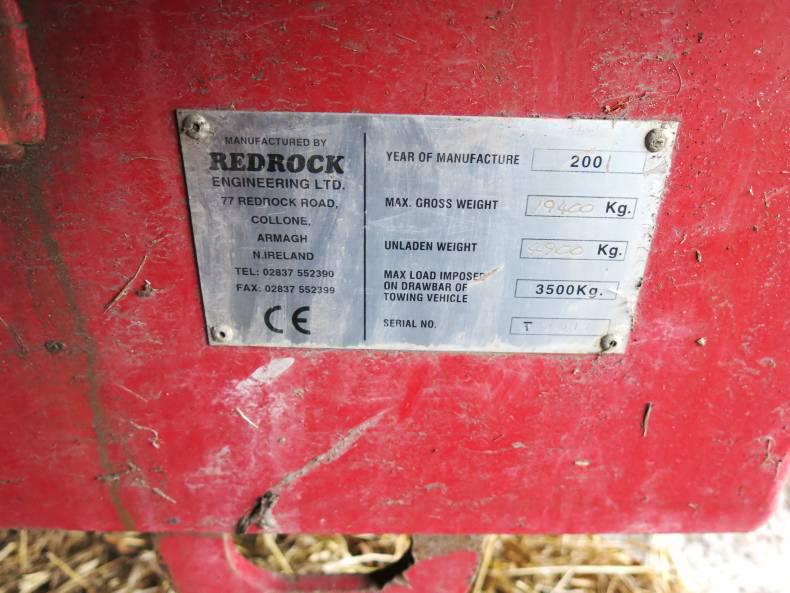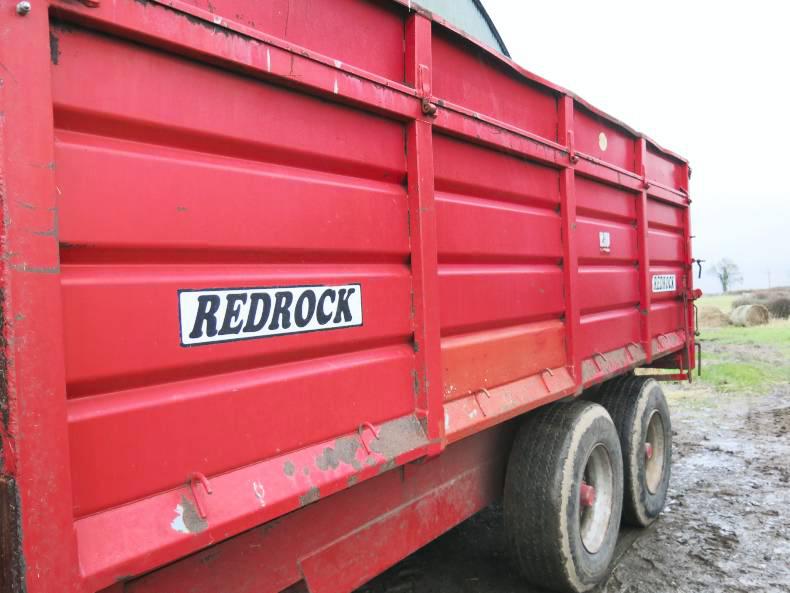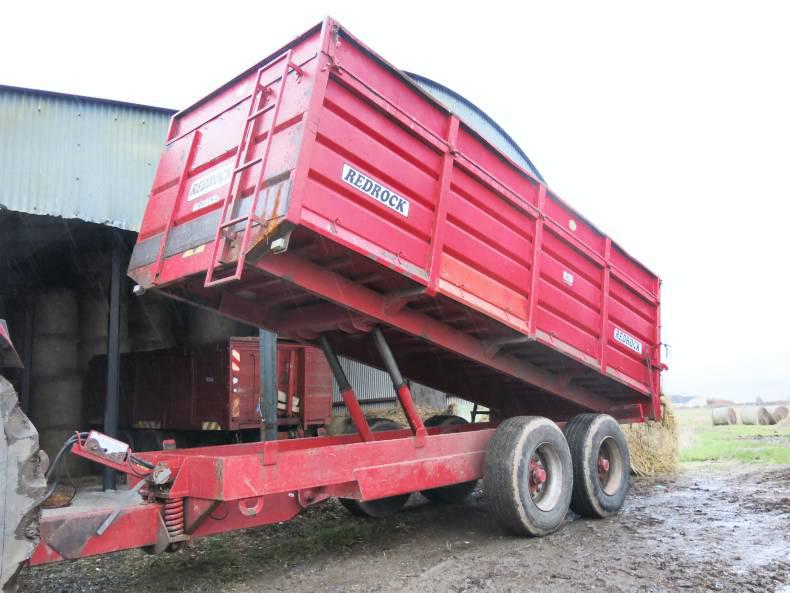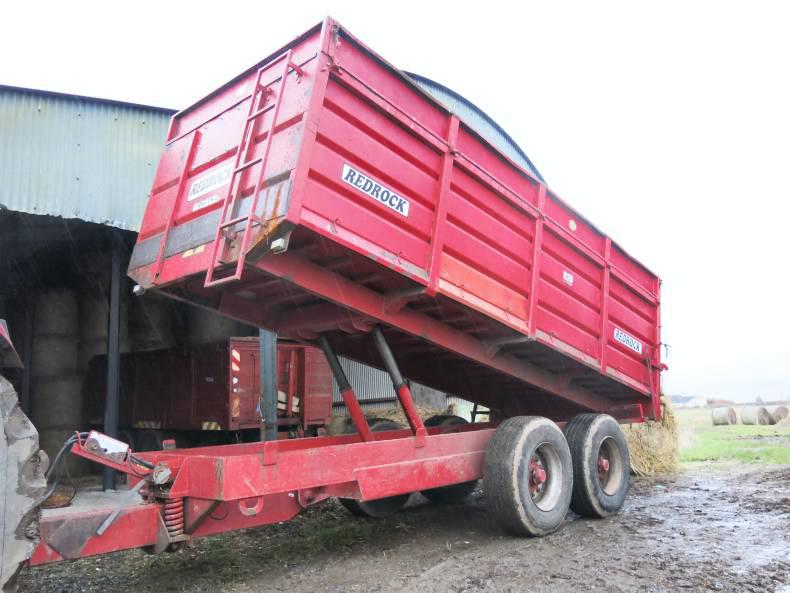As part of the trailers Focus the machinery team looked at editor James Maloney’s trailer to see how it fared under the new road rules. An 18ft 2001 Redrock in good condition on super single tyres sized 385/65 R 22.5 fitted on a bogie axle, the trailer is used for grain mainly. This type of trailer is very common on Irish farms, and up until this year has been drawn at speeds of over 40km/h. In this article we inspect the trailer for two work scenarios:
Updates needed for this trailer to travel up to 40km/h for 2016.Updates needed to travel at speeds in excess of 40km/h for 2016.
Picture one
This trailer is fitted with a bogie axle, which means travelling at speeds over 40km/hr is not ruled out straight away. The bogie axle is not considered a flexible suspension under the new rules.
This trailer is plated to carry 19,400kg which includes the weight of the trailer itself. Under the new rules, the trailer can still carry this weight under 40km/h. Even though it is a bogie with one hinge point, it can carry 8t per axle with an allowance of 3t on the drawbar. The option on this trailer is to remove the bogie and fit a flexible suspension system. Fitting this system on the trailer, allows for 9t per axle, with 3t on the drawbar. Adding 500mm flotation tyres or greater, allow for 10t weight per axle. Fitting a ball and spoon coupling system can increase the drawbar weight by 1t.
The trouble may start here – fitting a new axle on an existing trailer can lead to problems with the chassis design. Wider braking hubs and wheel arches may be needed to fit the new axle to meet the requirements for use at over 40km/h. This may require alterations to the original design build of the trailer.

Picture two
The axle spacing on this trailer is 1.3m and it is fitted with standard-sized super single tyres. To travel at speeds under 40km/h and carry the existing weight on the trailer, no changes are required to the axle. On this trailer the axle will have to be changed to a commercial specification design to travel at speeds over 40km/h and carry increased permissible weight.

Picture three
This trailer built in 2001 is fitted with 400X80 mm brake hubs, known as agricultural 40km/h axles. This type of braking system if in good working order, will meet the specification for 40km/h, which requires 25% braking efficiency. The trailer will never reach the 45% efficiency required for either air or hydraulic braking systems for use over 40km/h. The scenario here is again to fit the trailer with a new axle with wider commercial brake hubs which are 420X180mm. This will give a greater braking surface area in the hub. New-build trailers must have auto slack adjusters. However, if in place, manual slack adjusters will suffice on trailers manufactured before January 2016.

Picture four
The breakaway system on the trailer at the moment is not there, so one will have to be fitted. The legislation states for this trailer to be used at under 40 km/h, fitting a secondary coupling system such as a chain or wire rope will suffice. Ideally fitted to the bottom of the tractor hitch and welded to the trailer drawbar. An automatic breakaway system will have to be fitted to this trailer for use over 40km/h. This device may be a hydraulic valve connected via a cable to the tractor, electronic breakaway device, manual connection to handbrake, or air brakes with red line breakaway pipe. All new trailers manufactured after January 2016 will require air brakes as standard for use over 40 km/h. An automatic breakaway device is required for all trailers manufactured after 1 January 2016, regardless of the speed being towed. All trailers must have a parking brake with 16% braking efficiency. This must to be fitted or repaired on all trailers regardless of speed category.

Picture five
This trailer was originally plated by the manufacturer in 2001. This will again be OK for use at 40km/h if the trailer’s laden weight is not over three times the weight of the tractor or 19t for tandem axle trailers. If this trailer is amended to travel at speeds over 40km/h, a new inspection and plating by an authorised distributor or manufacturer is required. Some manufacturers have made it known to the Irish Farmers Journal that they will only carry out retrofitting to their own trailers. These manufacturers will plate all trailers, if the work carried out on the trailer is of the required standard. This costs €130 approximately to carry out the test and place a 50km/h speed sticker on the rear of the trailer.

Picture six
The trailer’s existing lights must be in working order and located correctly. Under the new rules, reflective side markings on the trailer are required for both over and under 40km/hr. On this 18ft trailer, it costs around €36 plus VAT. The trailer must also be fitted with a marker lamp on their right-hand side if, when coupled to an agricultural tractor, the overall length of the combination is more than 10m. The marker lamps must be fitted at least 25cm from the ground and not more than 3m from the front of the trailer. When carrying out alterations to lights, it is a good opportunity to inspect for any potential damage, and fit neat junction boxes.
As can be seen from Table 1, the cost to update the Redrock trailer to be legally towed up to 40km/h is €146 plus VAT. This price, however, does not allow for the labour and time involved in carrying out this work. In order to get the Redrock up to standard to be to towed in excess of 40km/h the materials will cost €2,746 plus VAT. Again this price does not reflect fitting costs, which may be substantial.
While carrying out this work, it is often a good time to check over other components on your trailer such as lights, hydraulic system and tyres.

Cost of New 2016 Spec Trailer
The Irish Farmers Journal machinery team asked three trailers manufacturers to price a new 2016 spec grain trailer with the following:
18ft grain trailer:Commercial high-speed (105km/h) axles with auto slack adjusters.560/60/22.5 flotation tyres.Standard tailboard.Load-sensing air brakes including breakaway system.Lights/speed disc/reflective side and rear markingsParking BrakeThe prices were as follows:
Smyth Trailers €15,000 + VatBroughan Trailers €14,700 + VatDooley Bros Trailers €14,800 + VatThe proposed trailer for modification has an approximate trade-in value of €6,000 plus VAT. Taking into account the cost and time involved in retrofitting the Redrock, it may be more feasible to trade in the trailer and purchase a new model up to the 2016 standard. For the Redrock trailer to come up to the specification of the proposed new trailer option, it approximately costs €6,046 plus VAT, excluding time, labour and potential headaches.
As part of the trailers Focus the machinery team looked at editor James Maloney’s trailer to see how it fared under the new road rules. An 18ft 2001 Redrock in good condition on super single tyres sized 385/65 R 22.5 fitted on a bogie axle, the trailer is used for grain mainly. This type of trailer is very common on Irish farms, and up until this year has been drawn at speeds of over 40km/h. In this article we inspect the trailer for two work scenarios:
Updates needed for this trailer to travel up to 40km/h for 2016.Updates needed to travel at speeds in excess of 40km/h for 2016.
Picture one
This trailer is fitted with a bogie axle, which means travelling at speeds over 40km/hr is not ruled out straight away. The bogie axle is not considered a flexible suspension under the new rules.
This trailer is plated to carry 19,400kg which includes the weight of the trailer itself. Under the new rules, the trailer can still carry this weight under 40km/h. Even though it is a bogie with one hinge point, it can carry 8t per axle with an allowance of 3t on the drawbar. The option on this trailer is to remove the bogie and fit a flexible suspension system. Fitting this system on the trailer, allows for 9t per axle, with 3t on the drawbar. Adding 500mm flotation tyres or greater, allow for 10t weight per axle. Fitting a ball and spoon coupling system can increase the drawbar weight by 1t.
The trouble may start here – fitting a new axle on an existing trailer can lead to problems with the chassis design. Wider braking hubs and wheel arches may be needed to fit the new axle to meet the requirements for use at over 40km/h. This may require alterations to the original design build of the trailer.

Picture two
The axle spacing on this trailer is 1.3m and it is fitted with standard-sized super single tyres. To travel at speeds under 40km/h and carry the existing weight on the trailer, no changes are required to the axle. On this trailer the axle will have to be changed to a commercial specification design to travel at speeds over 40km/h and carry increased permissible weight.

Picture three
This trailer built in 2001 is fitted with 400X80 mm brake hubs, known as agricultural 40km/h axles. This type of braking system if in good working order, will meet the specification for 40km/h, which requires 25% braking efficiency. The trailer will never reach the 45% efficiency required for either air or hydraulic braking systems for use over 40km/h. The scenario here is again to fit the trailer with a new axle with wider commercial brake hubs which are 420X180mm. This will give a greater braking surface area in the hub. New-build trailers must have auto slack adjusters. However, if in place, manual slack adjusters will suffice on trailers manufactured before January 2016.

Picture four
The breakaway system on the trailer at the moment is not there, so one will have to be fitted. The legislation states for this trailer to be used at under 40 km/h, fitting a secondary coupling system such as a chain or wire rope will suffice. Ideally fitted to the bottom of the tractor hitch and welded to the trailer drawbar. An automatic breakaway system will have to be fitted to this trailer for use over 40km/h. This device may be a hydraulic valve connected via a cable to the tractor, electronic breakaway device, manual connection to handbrake, or air brakes with red line breakaway pipe. All new trailers manufactured after January 2016 will require air brakes as standard for use over 40 km/h. An automatic breakaway device is required for all trailers manufactured after 1 January 2016, regardless of the speed being towed. All trailers must have a parking brake with 16% braking efficiency. This must to be fitted or repaired on all trailers regardless of speed category.

Picture five
This trailer was originally plated by the manufacturer in 2001. This will again be OK for use at 40km/h if the trailer’s laden weight is not over three times the weight of the tractor or 19t for tandem axle trailers. If this trailer is amended to travel at speeds over 40km/h, a new inspection and plating by an authorised distributor or manufacturer is required. Some manufacturers have made it known to the Irish Farmers Journal that they will only carry out retrofitting to their own trailers. These manufacturers will plate all trailers, if the work carried out on the trailer is of the required standard. This costs €130 approximately to carry out the test and place a 50km/h speed sticker on the rear of the trailer.

Picture six
The trailer’s existing lights must be in working order and located correctly. Under the new rules, reflective side markings on the trailer are required for both over and under 40km/hr. On this 18ft trailer, it costs around €36 plus VAT. The trailer must also be fitted with a marker lamp on their right-hand side if, when coupled to an agricultural tractor, the overall length of the combination is more than 10m. The marker lamps must be fitted at least 25cm from the ground and not more than 3m from the front of the trailer. When carrying out alterations to lights, it is a good opportunity to inspect for any potential damage, and fit neat junction boxes.
As can be seen from Table 1, the cost to update the Redrock trailer to be legally towed up to 40km/h is €146 plus VAT. This price, however, does not allow for the labour and time involved in carrying out this work. In order to get the Redrock up to standard to be to towed in excess of 40km/h the materials will cost €2,746 plus VAT. Again this price does not reflect fitting costs, which may be substantial.
While carrying out this work, it is often a good time to check over other components on your trailer such as lights, hydraulic system and tyres.

Cost of New 2016 Spec Trailer
The Irish Farmers Journal machinery team asked three trailers manufacturers to price a new 2016 spec grain trailer with the following:
18ft grain trailer:Commercial high-speed (105km/h) axles with auto slack adjusters.560/60/22.5 flotation tyres.Standard tailboard.Load-sensing air brakes including breakaway system.Lights/speed disc/reflective side and rear markingsParking BrakeThe prices were as follows:
Smyth Trailers €15,000 + VatBroughan Trailers €14,700 + VatDooley Bros Trailers €14,800 + VatThe proposed trailer for modification has an approximate trade-in value of €6,000 plus VAT. Taking into account the cost and time involved in retrofitting the Redrock, it may be more feasible to trade in the trailer and purchase a new model up to the 2016 standard. For the Redrock trailer to come up to the specification of the proposed new trailer option, it approximately costs €6,046 plus VAT, excluding time, labour and potential headaches.













 This is a subscriber-only article
This is a subscriber-only article











SHARING OPTIONS: